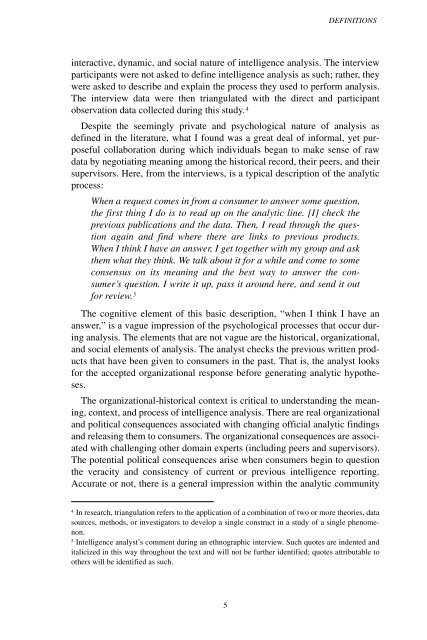Analytic Culture in the U.S. Intelligence Community (PDF) - CIA
Analytic Culture in the U.S. Intelligence Community (PDF) - CIA
Analytic Culture in the U.S. Intelligence Community (PDF) - CIA
Create successful ePaper yourself
Turn your PDF publications into a flip-book with our unique Google optimized e-Paper software.
DEFINITIONS<br />
<strong>in</strong>teractive, dynamic, and social nature of <strong>in</strong>telligence analysis. The <strong>in</strong>terview<br />
participants were not asked to def<strong>in</strong>e <strong>in</strong>telligence analysis as such; ra<strong>the</strong>r, <strong>the</strong>y<br />
were asked to describe and expla<strong>in</strong> <strong>the</strong> process <strong>the</strong>y used to perform analysis.<br />
The <strong>in</strong>terview data were <strong>the</strong>n triangulated with <strong>the</strong> direct and participant<br />
observation data collected dur<strong>in</strong>g this study. 4<br />
Despite <strong>the</strong> seem<strong>in</strong>gly private and psychological nature of analysis as<br />
def<strong>in</strong>ed <strong>in</strong> <strong>the</strong> literature, what I found was a great deal of <strong>in</strong>formal, yet purposeful<br />
collaboration dur<strong>in</strong>g which <strong>in</strong>dividuals began to make sense of raw<br />
data by negotiat<strong>in</strong>g mean<strong>in</strong>g among <strong>the</strong> historical record, <strong>the</strong>ir peers, and <strong>the</strong>ir<br />
supervisors. Here, from <strong>the</strong> <strong>in</strong>terviews, is a typical description of <strong>the</strong> analytic<br />
process:<br />
When a request comes <strong>in</strong> from a consumer to answer some question,<br />
<strong>the</strong> first th<strong>in</strong>g I do is to read up on <strong>the</strong> analytic l<strong>in</strong>e. [I] check <strong>the</strong><br />
previous publications and <strong>the</strong> data. Then, I read through <strong>the</strong> question<br />
aga<strong>in</strong> and f<strong>in</strong>d where <strong>the</strong>re are l<strong>in</strong>ks to previous products.<br />
When I th<strong>in</strong>k I have an answer, I get toge<strong>the</strong>r with my group and ask<br />
<strong>the</strong>m what <strong>the</strong>y th<strong>in</strong>k. We talk about it for a while and come to some<br />
consensus on its mean<strong>in</strong>g and <strong>the</strong> best way to answer <strong>the</strong> consumer’s<br />
question. I write it up, pass it around here, and send it out<br />
for review. 5<br />
The cognitive element of this basic description, “when I th<strong>in</strong>k I have an<br />
answer,” is a vague impression of <strong>the</strong> psychological processes that occur dur<strong>in</strong>g<br />
analysis. The elements that are not vague are <strong>the</strong> historical, organizational,<br />
and social elements of analysis. The analyst checks <strong>the</strong> previous written products<br />
that have been given to consumers <strong>in</strong> <strong>the</strong> past. That is, <strong>the</strong> analyst looks<br />
for <strong>the</strong> accepted organizational response before generat<strong>in</strong>g analytic hypo<strong>the</strong>ses.<br />
The organizational-historical context is critical to understand<strong>in</strong>g <strong>the</strong> mean<strong>in</strong>g,<br />
context, and process of <strong>in</strong>telligence analysis. There are real organizational<br />
and political consequences associated with chang<strong>in</strong>g official analytic f<strong>in</strong>d<strong>in</strong>gs<br />
and releas<strong>in</strong>g <strong>the</strong>m to consumers. The organizational consequences are associated<br />
with challeng<strong>in</strong>g o<strong>the</strong>r doma<strong>in</strong> experts (<strong>in</strong>clud<strong>in</strong>g peers and supervisors).<br />
The potential political consequences arise when consumers beg<strong>in</strong> to question<br />
<strong>the</strong> veracity and consistency of current or previous <strong>in</strong>telligence report<strong>in</strong>g.<br />
Accurate or not, <strong>the</strong>re is a general impression with<strong>in</strong> <strong>the</strong> analytic community<br />
4<br />
In research, triangulation refers to <strong>the</strong> application of a comb<strong>in</strong>ation of two or more <strong>the</strong>ories, data<br />
sources, methods, or <strong>in</strong>vestigators to develop a s<strong>in</strong>gle construct <strong>in</strong> a study of a s<strong>in</strong>gle phenomenon.<br />
5<br />
<strong>Intelligence</strong> analyst’s comment dur<strong>in</strong>g an ethnographic <strong>in</strong>terview. Such quotes are <strong>in</strong>dented and<br />
italicized <strong>in</strong> this way throughout <strong>the</strong> text and will not be fur<strong>the</strong>r identified; quotes attributable to<br />
o<strong>the</strong>rs will be identified as such.<br />
5
















